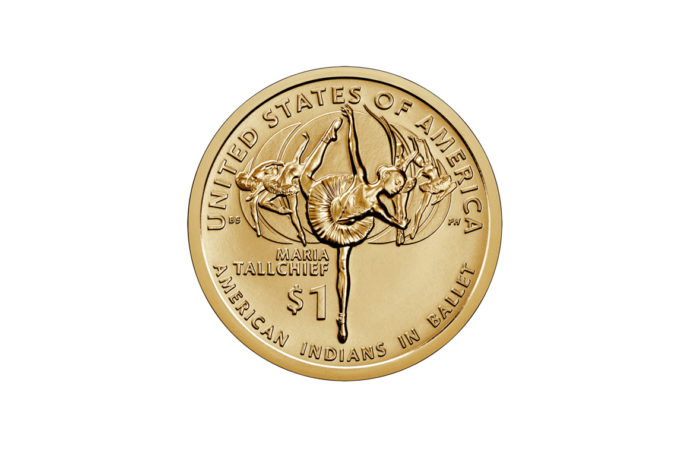PAWHUSKA, OK – The United States Mint has released its new $1 coin, featuring the Osage Nation’s own Maria Tallchief (1925 – 2013). In the background on the coin, in silhouette, are depicted her sister Marjorie Tallchief (1926 – 2021), as well as Yvonne Chouteau (Cherokee, 1929 – 2016), Moscelyne Larkin (Peoria, 1925 – 2012), and Rosella Hightower (Choctaw, 1920 – 2008). Collectively, these five Native ballerinas, all from Oklahoma tribal nations, became known as the “Five Moons.”
“My mother would have been so moved by being included on the dollar coin,” said Elise Paschen, Tallchief’s daughter, who is a renowned poet and professor at the Art Institute of Chicago. “I worked with the U.S. Mint on the design of the silver dollar and am pleased that the Five Moons were incorporated.”
The U.S. Mint themed the coin “Maria Tallchief and American Indians in Ballet,” which is engraved on the coin. The new coin continues the U.S. Mint’s $1 Coin Program that began in 2009 to celebrate the important contributions made by tribal nations and individual Native people to the history and development of the United States. The program was authorized by the Native American $1 Coin Act (Public Law 105-124) that was signed into law in 1997. The coin series follows the release of the Sacagawea Golden Dollar (2000 to 2008), which features a portrait of Sacagawea on the obverse side (heads) with an eagle on the reverse (tails side). The reverse side of these coins changes year-to-year, however.
“The obverse (heads) design retains the central figure “Sacagawea” carrying her infant son, Jean Baptiste,” according to the U.S. Mint. “The reverse (tails) design features Maria Tallchief in balletic pose. A nod to the ‘Five Moons’ is presented in the lunar motif, while the four ballerinas in the background are symbolic of both Tallchief’s American Indian ballerina contemporaries and the generations of dancers they inspired.”
Tallchief is the only member of the Five Moons named on the coin, however, each of the five Native ballerinas achieved international stardom in the famous Ballet Russe de Monte Carlo, as well as other major ballet companies around the world, including the Paris Opéra Ballet, New York City Ballet, American Ballet Theater, Tulsa Ballet, Oklahoma City Ballet, and the University of Oklahoma School of Dance. Tallchief is considered America’s first “prima ballerina” and also the first Native American to earn the rank. She was inducted into the Women’s Hall of Fame in 1996, and received a National Medal of Arts in 1999.
“Maria Tallchief paved a path against great odds and sometimes great resistance to become the first Native American prima ballerina to star on the world stage,” said Geoffrey Standing Bear, Principal Chief of the Osage Nation. “She diversified ballet with her very presence as an Osage woman, forever opening the doors for future dancers of color.”
The dancers are memorialized together in the Oklahoma State Capitol rotunda in a mural titled “Flight of Spirit,” painted by Chickasaw artist Mike Larsen and unveiled in 1991. In addition to the capitol mural, the five ballerinas are also honored in Tulsa Historical Society’s Vintage Garden where bronze sculptures depict the ballerinas in various signature roles. The Five Moons sculptures were created by Monte England and Gary Henson and unveiled in 2007. Sadly, Marjorie Tallchief’s statue was stolen from the garden last year and sold for scrap metal. Pieces of the statue were recovered, however, and are being reassembled by Henson to be reinstated soon in her place of honor among the other sculptures.
Later this year, “The Maria Tallchief Quarter” will be released and become the 10th coin in the American Women Quarters™ Program. The coin will depict Tallchief in one of her break-out roles, “The Firebird,” in spotlit balletic pose. Significantly, Tallchief’s Osage name will be etched on the coin, an act of tribal sovereignty guided by numerous Osage leaders, including Herman “Mogri” Lookout, Vann Bighorse, and Chad Renfro, among others. “Wa-Xthe-Thoṉba,” her Osage name highlighted on the coin, translates to “Two Standards” and was given to Tallchief by the Osage Tribal Council when the state of Oklahoma created “Maria Tallchief Day” on June 29, 1953. The name was selected by her grandmother, Eliza Bigheart Tallchief, to reflect Tallchief’s life in two worlds – as an Osage woman who danced to traditional songs, and as a prima ballerina, who danced her way into the hearts of ballet lovers around the world.
Tallchief was born on January 24, 1925, in Fairfax, OK, to Alex and Ruth Porter Tallchief. She began dancing at a very young age and also excelled at playing piano. She practiced dance and piano nearly every minute that she was not in Catholic School down the hill from her house.
“She couldn’t ever come out to play because she was always practicing,” said Lookout, an Osage elder and Director of the Osage Nation Language Department. “She was magnificent. I was sure proud of her.”













































